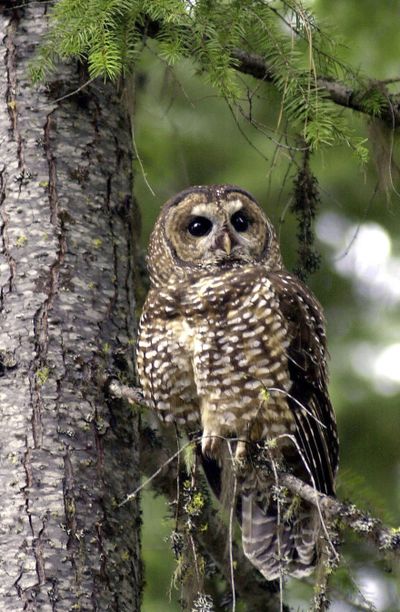Plan: Kill one bird to save another
Attempt to protect spotted owl calls for shooting barred owls

WASHINGTON – To save the imperiled spotted owl, the Obama administration is moving forward with a controversial plan to shoot barred owls, a rival bird that has shoved its smaller cousin aside.
The plan is the latest federal attempt to protect the northern spotted owl, the passive, one-pound bird that sparked a battle over logging in the Pacific Northwest two decades ago.
The government set aside millions of acres of forest to protect the owl, but the bird’s population continues to decline – a 40 percent slide in 25 years.
A plan announced Tuesday would designate habitat considered critical for the bird’s survival, while allowing logging to reduce the risk of catastrophic wildfire and to create jobs. Habitat loss and competition from barred owls are the biggest threats to the spotted owl.
Interior Secretary Ken Salazar called the draft plan “a science-based approach to forestry that restores the health of our lands and wildlife and supports jobs and revenue for local communities.”
By removing selected barred owls and better managing forests, officials can give communities, foresters and land managers in three states important tools to promote healthier and more productive forests, Salazar said.
The new plan, which replaces a 2008 Bush administration plan that was tossed out in federal court, affects millions of acres of national, state and private forest land in Washington, Oregon and Northern California.
The latest plan for spotted owls was accompanied by a presidential memorandum directing the Department of the Interior to take a number of steps before the plan is finalized, including providing clear direction for how logging can be conducted within areas designated as critical habitat and conducting an economic analysis at the same time critical habitat areas are proposed.
Officials acknowledge that the plan to kill barred owls creates an ethical dilemma but say an experiment on private land in Northern California has shown promising results. Spotted owls have returned to historic territories after barred owls were removed.
Salazar and other officials stressed the new plan’s job-creation component, noting that for the first time logging would be allowed in areas designated as critical habitat for the owl.
The American Forest Resource Council, a timber industry group, was skeptical that so-called ecological logging would produce a significant amount of timber or jobs. At the same time, the plan has the potential to double the acres designated as critical habitat, said Tom Partin, the group’s president.
Conservationists also were wary. Steve Holmer of the American Bird Conservancy said his group was pleased that the administration was moving carefully to kill barred owls but said officials appeared to be endorsing a big boost in logging inside critical habitat boundaries with no scientific studies showing it works.